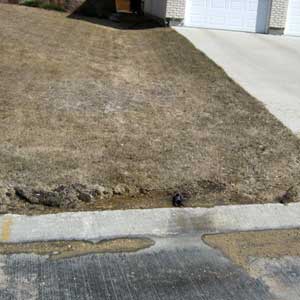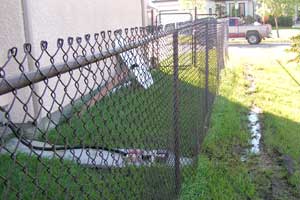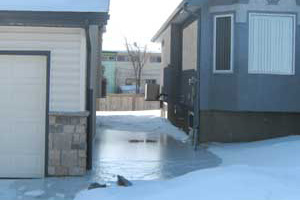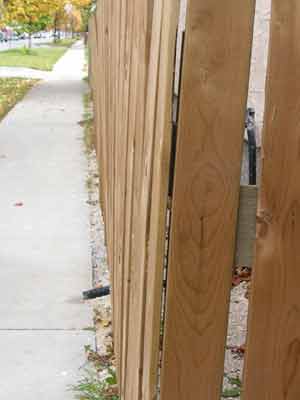Sump pump discharge
Sump pit drainage systems are designed to protect your home from sewer backups.
A sump pit drainage system includes:
- A sump pit, which is set in the basement floor and collects water from the weeping tiles around your basement.
- A sump pump, which pushes the water outside your house through the hose.
- A discharge hose, which drains the water out onto your property.
It’s important to make sure your sump pump discharge hose is in the right place to avoid violating City of Winnipeg by-laws.
Place the hose so that the water from your sump pump:
- Drains away from your house, preferably onto a grassy area or non-paved surface, and
- Is absorbed on your property.
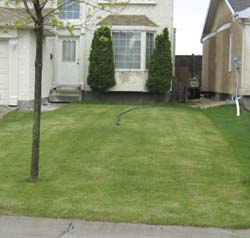 |
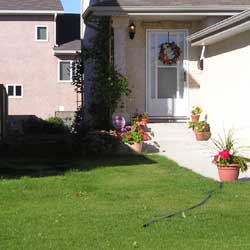 |
Tips
- Use the water from the sump pump to water grass, shrubs and trees on your property.
- Move the hose often so that you don't overwater any one area.
Frequently asked questions
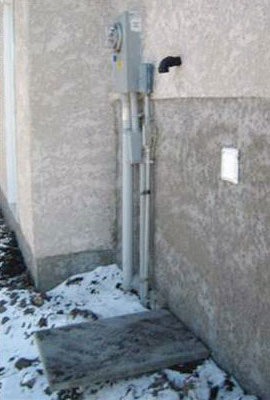 |
Weeping tile water that collects in your sump pit should not go in the sewer system for two reasons:
- It increases the risk of basement flooding for you and your neighbours. The sewer system is designed to manage only normal flows of wastewater, not sump pump water.
- It prevents unnecessary increases in sewer costs to you, our customer, since it is clean water and does not need to be treated. If you discharge sump pump water to the sewer, it flows to a wastewater treatment plant. This can result in extra wear and tear on equipment, and even require an increase in the size of the plant. We then recover these added treatment costs by increasing the sewer rate.
It causes hazardous conditions for pedestrians, cyclists and motorists.
- In summer, algae or mould can grow on sidewalks and the street, creating slippery conditions.
- In winter, ice build-up causes slippery conditions.
No, because there is a risk of overwatering. Young, newly transplanted trees are particularly sensitive.
Never unplug your sump pump.
If water in the sump pump hose freezes, your sump pump can overheat and burn out. There are two ways of preventing this. Try them out to see which works for your property.
In the fall, once the weather drops below freezing, disconnect the flexible sump pump hose outside.
- If you don't already have one, attach a 90 degree elbow to the discharge outlet, and place a splash pad under the discharge outlet
- Fasten a larger size flexible, perforated drain hose or pipe (4" or 6" diameter) of suitable length to the discharge outlet (e.g., a piece of weeping tile pipe)
Remember! In spring, reattach the hose you normally use or leave the winter one in place if it drains the water properly in spring and summer.
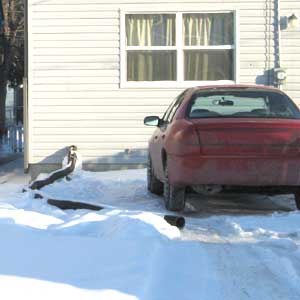
Contact 311. We will then contact you to arrange a time to meet with you at home to review your situation.
If the water is draining towards the property line between you and your neighbour:
- Check your own lot grading to ensure that your property is sloped to the property line and not draining back towards your house. Draining sump pump water to the property line, which then drains towards (but not directly onto) the street or lane, is normal.
- Talk to your neighbour to try and work out a solution. He or she may not realize there is a problem.
You can try to:
- Consult with a professional (e.g., landscape contractor or landscape architect).
- Contact us to investigate. Our lot grading inspector will examine both properties and recommend improvements.
Yes. If we find a property where the water is draining improperly, we will issue a notice of By-law violation. The owner must then correct the violation by the deadline on the notice.
Contact 311 if you have questions about sump pumps and sump pump discharge.
We send out these notices to property owners who are draining water from their sump pump illegally. The City of Winnipeg Lot Grading By-law states that water from sump pumps must not drain directly:
- onto neighbouring properties,
- onto lanes or streets,
- onto sidewalks,
- onto boulevards, or
- into the floor drain in your home.
If your neighbour's sump pump drains the same way as yours, your neighbor has probably received a notice as well. When someone reports a by-law violation, we inspect the surrounding properties. We send notices to anyone we are aware of who is draining water from their sump pump illegally.
You may have been illegally discharging your sump pump water for many years, but now that we know about it, you must fix the problem. Occasionally, illegal sump pump drainage is not noticed because the discharge hose is buried beneath the grass or landscaping.
Once we notify you of the By-law violation, you must fix the problem by the deadline. If you ignore the notice, you are disobeying the by-law. We could take the following action:
- do the work ourselves and add the costs to your property tax bill,
- charge you for any of our costs resulting from your illegal sump pump drainage (e.g., for placing sand or removing ice to make public areas safe, for repairing damages to the sidewalk, street or lane), or
- prosecute you in Provincial Court.
Sump pumps play an important part in the City's sewer systems. They pump water from the weeping tiles out onto your property. This water is suitable for watering grass, plants, trees, and shrubs. Allowing this clean water to flow into the sewer system would unnecessarily increase treatment costs. Changes to the Manitoba Building Code in 1990 require that every new home have a sump pump.


